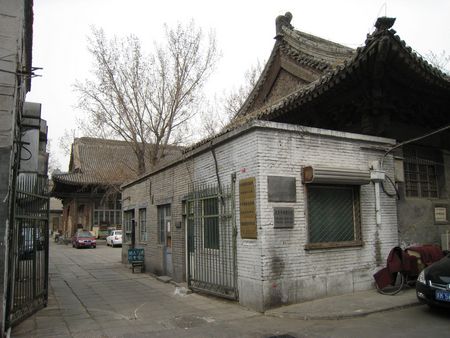Now and then -- The kaleidoscopic Beijige Santiao Hutong in Dongdan region
|
|
|
Photos: Yin Yeping |
If you happen to go to Dongdan region, do not forget to pop in the hutong called Beijige Santiao. Hidden at one side of the big Dongdan Beidajie to its west, this lane is veiled in its own shadow of history that outsiders might hardly understand. Upon arriving at this lane, it's clear that there has been some effort to preserve local history and cultural relics, but in between those spots are many more that have gone unnoticed or unlabeled.
The forgotten prince and his disregarded mansion
As a hutong that has been on the map since the Ming Dynasty (1368-1644), today's Beijige Santiao is full of tangible evidence that points to its venerable background. A few steps from the west access of the lane you may come across a traditional-style one story building. On its faded wall there is a notice telling how it was connected with the royal family back in the Qing Dynasty (1644-1911). This place was the old residence of a prince named Hong Jiao, the fourth son of Emperor Kang Xi's son Run Xiang. Though he was never emperor, Hong occupied an overwhelmingly exalted position when he was dubbed the Ning Jun prince in 1730. No 71. was where he lived during his golden days.
In spite of Hong's position, he did not play a big part in Chinese history and his name was eventually forgotten, but his house, however, continued to play host to the tides of history. It was used for dancing and entertainment during the Japanese occupation, and later it became a car workshop. After 1949, the China Youth Art Theater, today's National Theater Company of China (NTCC) occupied the space as a rehearsal venue and dormitory.
Much of the old architecture still stands in spite of the constant occupation, but overall the current condition is not very good. Three NTCC related organizations share No. 71, and it's become quite crowded. Many small houses added later to the big mansion lean haphazardly on one side of its outside wall, and ventilation holes in its cracked walls can't help but make one apprehensive about the building's future. This is a one-courtyard building with a huge empty space in front of the main hall that has been luckily kept original. The side halls are partially in the old style either. The staff inside said that these three buildings have been used as a storeroom, dormitory and office building.
Possibly because its shabby appearance is inappropriate to be photographed, doorkeepers are always around at No. 71 to prevent anyone from getting inside to take pictures.
 0
0 








Go to Forum >>0 Comments